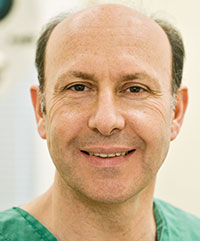Wrinkles caused by muscle activity can occur at a young age and can be treated effectively with Botox (crows feet, frown lines, etc.). Wrinkles caused by the loss of intrinsic elasticity of the skin, are best corrected by streamlining operations (face lift, etc.). The loss of subcutaneous fat may be offset only by the introduction of body fat or artificial fillers (“filler”).
The first artificial filler was most likely paraffin, which was already used in 1900 to correct material defects. Due to serious complications, it was discontinued. About 1950, they used animal collagen and silicone oil. In collagen, there were frequent allergic reactions (animal protein), intolerance occurred in silicone oil. Around 1990 the first Hyaluronic acid preparations were put on the market. Hyaluronic acid is a sugar molecule, found in the human body and has some important features. Hyaluronic acid binds water in the skin (1,000 times the amount of the net weight), based on a mechanically resilient, three-dimensional network between cells and collagen fibers and stimulates the formation of fibroblasts (connective tissue). The ability to retain water gives the hyaluronic acid viscoelasticity and therefore it is well suited for injection.
A functional classification of a filler is possible in the following categories:
- “Totally degradable” (resorbable), degradation takes place within 4-6 months
- “Delayed degradable” (delayed absorbable), degradation takes place within one year
- “Non-degradable” (not absorbable) is not degraded by the body
- Mixed preparations
Hyaluronic acid is one of the resorbable fillers currently available under the following product names: Hylaform, AcHyal, Belotero, Hyal2000, HylanSeS, Jolidermis, Juvéderm, Perlane, Puragen, Restylane, Revanesse, Rofilan Hylan gel and Teosyal. The absorbable collagen fillers include Resoplast, Zyderm, Zyplast, Fibrel, Permacol, Evolence, Cymetra, CosmoDerm, Cosmoplast, autologous or isologous.
The delayed absorbable fillers include Radiesse and New Fill. Among the non-absorbable fillers are Amazinggel, Aquamid, Argiform, Evolution, Outline, Bio-Alcamid, Adato Sil-ol 5000, Bioplastique, Dermage, Silicex or silicone 1000th. Mixed preparations of absorbable and nonabsorbable are Artecoll/ArteFill, Dermalive or Dermadeep.
Permanent fillers or delayed absorbable substances pose a certain risk with regard to incompatibility reactions or nodules. For this reason I only use Hyaluronic acid as an artificial filler or transplant the body’s own fat.
Fillers can be used in all areas of the face, most often they are used to plump the lips, correct nasolabial folds, correct eye rings or add padding to the zygomatic region.
If used properly, fillers are safe and side effects are uncommon, after the treatment there is neither pain nor down time. In addition, the procedure leads to significant visible improvements with minimal time and financial burden. With consistent application over the years it might be worth considering using one’s own body fat as a filler. Although using your own body fat is initially more expensive, it is cheaper in the long run because autologous fat does not need to be repeated once the desired volume has been reached.


